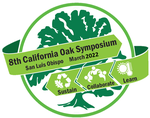#58

Chad Roberts (retired conservation ecologist)
Recent oak-genome studies indicate that California’s native oak clades originated in North America at least 40 million years ago, and (with minor exceptions) have evolved separately from other oak clades in North America and Eurasia. Species within each major clade form a syngameon, in which multiple species share genes and all species are genetically enriched, although individual species consistently demonstrate ecological separations from related species, shaped by local environmental conditions. Oak species diversity in California arose in part because species in each clade evolved to overlap ecologically with species in other clades, resulting in coexistence of multiple clades in occupied habitats.
California oak clades diversified coincident with development of California’s Mediterranean-type climate. California’s landscape itself evolved significantly during that timeframe, increasing the range of available habitat conditions. California’s native oaks are evolutionarily suited to conditions expected to be widespread with hotter, drier climate. Pollen data from the last 120,000 years indicate that oak dominance typically increased during warmer, drier climate intervals. Most California oak species exhibit enhanced drought tolerance, with greater resistance to xylem cavitation than in most conifer species and hardwood species. Most oak species readily sprout if top-killed by fire. Species in each major clade participate in a fire-mediated ecological dance with competing conifers, which have similar evolutionary histories.
Climate change is projected to increase ambient temperatures and seasonal droughts in California, shifting species distributions, altering plant community compositions in favor of deciduous species, and altering ecosystem services. Increased wildfire occurrence and severity are observed effects of climate change now, and further departure from historical conditions is anticipated. The intrinsic genetic richness within native oak clades provides an expansive potential for oaks to respond to altered climate and fire with expanded ranges and increased abundances, providing a rich palette for restoration planning and climate-change adaptation.
